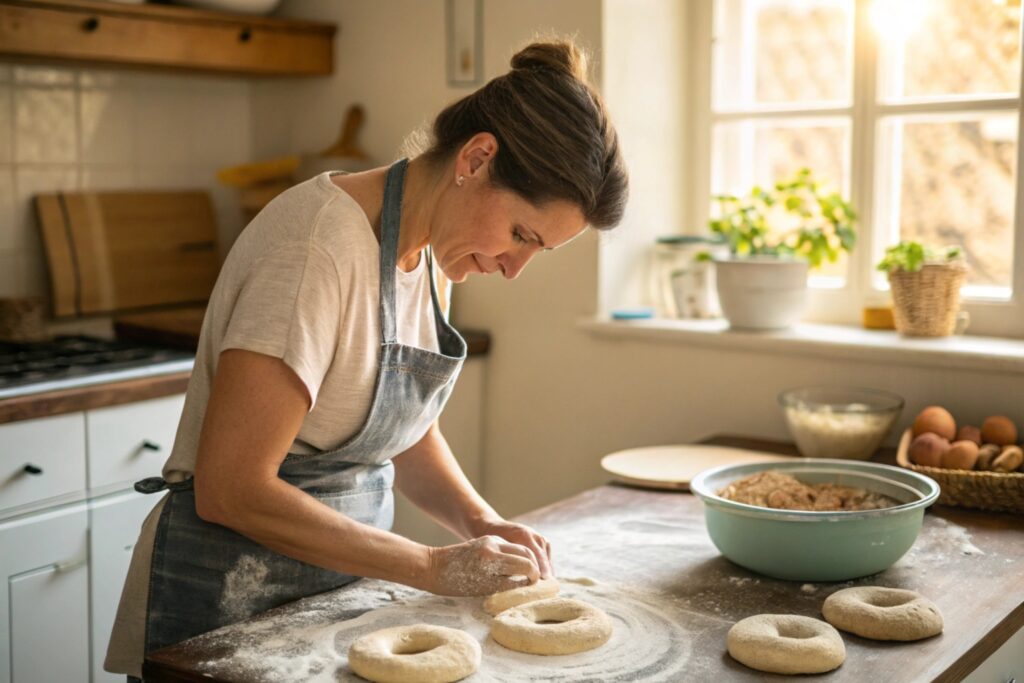Making sourdough bagels at home is a rewarding way to create chewy, delicious bagels that rival anything from a bagel shop. With a few essential tools, the right ingredients, and some patience, you can achieve a crispy crust and flavorful, soft interior. In this comprehensive guide, we’ll walk through every detail, from understanding the sourdough starter to boiling and baking your bagels to perfection. Let’s dive in!
Essential Equipment and Supplies
Before getting started, it’s important to have the right tools on hand. These items will make the process smoother and ensure your bagels come out just right:
- Mixing Bowl: For combining and kneading the dough.
- Dough Hook Attachment: If using a stand mixer for mixing and kneading.
- Kitchen Scale: Ensures accurate measurement of ingredients, especially for sourdough recipes.
- Parchment-lined Baking Sheet: Prevents sticking during the proofing and baking process.
- Plastic Wrap or Damp Kitchen Towel: Covers the dough while proofing.
- Spider Strainer or Slotted Spoon: Essential for handling bagels during the boiling process.
- Rimmed Tray or Baking Stone: Provides even heat distribution in the oven.
- Wire Rack: Allows bagels to cool without becoming soggy.
- Pot of Boiling Water: Necessary for the water bath that creates the signature bagel texture.
- Optional: A baking steel or Dutch oven for achieving optimal crust texture.
Key Ingredients for Sourdough Bagels
The key to a perfect sourdough bagel is using quality ingredients. Here’s what you’ll need:
- Active Sourdough Starter: A bubbly and active starter is the foundation of your bagel’s flavor and structure.
- Bread Flour: High-protein bread flour is essential for a chewy texture and proper gluten development.
- Warm Water (85-95°F): Helps activate the starter and dissolve ingredients.
- Brown Sugar or Barley Malt Syrup: Adds a subtle sweetness to the dough and enhances the crust during boiling.
- Kosher Salt: Balances the flavor and strengthens the dough structure.
- Optional Toppings: Sesame seeds, poppy seeds, bagel seasoning, or cinnamon sugar for a customized finish.
Understanding the Sourdough Starter
A sourdough starter is the heart of this recipe, providing natural leavening through wild yeast and lactic acid bacteria. Here’s what you need to know:
- Active Starter: Ensure your starter has been recently fed and is bubbly and doubled in size before use.
- Hydration Level: A 100% hydration starter (equal parts water and flour by weight) works best.
- Storing Starter: Keep it refrigerated when not in use, and feed it 1-2 times before baking to activate.
Simplified Baking Schedule
Timing is everything with sourdough. Use this schedule to streamline your process:
- Evening (Day 1): Mix and knead the dough, then allow it to rest for bulk fermentation (8-12 hours).
- Morning (Day 2): Shape the bagels and let them proof for 1-2 hours.
- Midday (Day 2): Boil and bake the bagels.
This overnight process lets you enjoy fresh bagels with minimal effort the next day.

Step-by-Step Instructions
1. Mixing the Dough
Combine the following in a large mixing bowl or stand mixer:
- 500g bread flour
- 250g warm water
- 100g active sourdough starter
- 20g brown sugar or barley malt syrup
- 10g kosher salt
Knead the mixture using the dough hook attachment on medium speed for 8-10 minutes, or knead by hand on a floured surface for 10-12 minutes, until the dough forms a smooth, elastic ball.
2. Stretching and Folding Techniques
During the first hour of bulk fermentation, perform 2-3 sets of stretch and folds to strengthen the dough:
- Step 1: Lightly wet your hands to prevent sticking and uncover the dough.
- Step 2: Gently pull one side of the dough upward until it stretches without tearing, then fold it over the center.
- Step 3: Rotate the bowl 90 degrees and repeat on the other three sides of the dough.
- Step 4: After completing the folds, re-cover the bowl with plastic wrap or a damp towel.
This process helps build gluten structure, creating a dough that is both strong and pliable.
3. Allowing for Bulk Rise
After the final stretch and fold, let the dough rest at room temperature (around 70-75°F) for 8-12 hours. Cover the bowl securely with plastic wrap or a damp towel to prevent the dough from drying out. During this bulk fermentation phase:
- The dough will double in size.
- The texture will become light and airy with visible bubbles forming on the surface.
If your kitchen is cooler, the process may take slightly longer. Conversely, in a warm environment, it might finish faster, so keep an eye on the dough’s progress.
4. Shaping the Bagels
Once the dough has completed its bulk rise, it’s time to shape it into bagels:
- Step 1: Gently turn the dough out onto a lightly floured surface to avoid deflating it too much.
- Step 2: Divide the dough into equal portions, typically 6-8 pieces (about 100g each).
- Step 3: Roll each piece into a smooth ball by cupping your hand over the dough and moving it in circular motions on the counter.
- Step 4: To create the bagel shape, poke a hole in the center of each ball with your thumb, then gently stretch it outward until the hole is about 1-2 inches in diameter.
- Step 5: Place the shaped bagels on a parchment-lined baking sheet, leaving space between them to allow for expansion.
5. The Second Rise Phase
After shaping, the bagels need a second proofing period to achieve the right texture:
- Step 1: Cover the shaped bagels loosely with a damp kitchen towel or plastic wrap to prevent drying.
- Step 2: Allow them to rise at room temperature for 1-2 hours, or until they appear slightly puffy but not overproofed.
During this time, prepare for the boiling step by setting up your pot and ingredients.
6. Preparing for Boiling
Boiling is a crucial step in creating the bagel’s characteristic chewy crust. Here’s how to prepare:
- Step 1: Fill a large pot with water, ensuring there’s enough depth for the bagels to float freely.
- Step 2: Add 1 tablespoon of brown sugar or barley malt syrup to the water. This helps create a glossy, golden crust during baking.
- Step 3: Bring the water to a gentle boil over medium-high heat and maintain it at a steady temperature while you boil the bagels.
Set up a spider strainer or slotted spoon nearby for handling the bagels.
7. Boiling the Bagels: Why and How
Boiling is what gives bagels their signature texture. Follow these steps:
- Step 1: Gently lower the bagels into the boiling water using a spider strainer or slotted spoon. Avoid overcrowding the pot—boil 2-3 bagels at a time.
- Step 2: Boil each side of the bagel for 30-60 seconds. For a chewier texture, boil closer to 60 seconds per side.
- Step 3: Remove the bagels from the water and place them back on the parchment-lined baking sheet. If desired, sprinkle toppings (like sesame seeds or poppy seeds) onto the wet bagels immediately after boiling.
This step ensures a dense, chewy crust that’s quintessential to a great bagel.
8. Baking the Bagels to Perfection
Preheat your oven to 425°F. Bake the boiled bagels for 20-25 minutes, rotating the tray halfway through. Look for a golden-brown crust.
Variations to Experiment With
Flavoring Your Bagels
- Cinnamon Raisin: Add 1 tsp cinnamon and ½ cup raisins to the dough.
- Jalapeno Cheddar: Mix in diced jalapenos and shredded cheddar.
- Chocolate Chip: Fold in 1 cup of chocolate chips.
Topping Suggestions for Different Palates
- Sesame seeds
- Poppy seeds
- Everything bagel seasoning
- Flaked salt
- Cheese shreds
Pair your sourdough bagels with delicious egg recipes for a wholesome breakfast.
Nutritional Benefits of Sourdough Bagels
Sourdough bagels offer a range of benefits compared to yeasted bagels:
- Digestibility: The fermentation process breaks down gluten and increases nutrient absorption.
- Flavor: Sourdough’s tangy flavor adds complexity.
- Long Shelf Life: Natural acidity helps preserve freshness.
Tips for Storing Sourdough Bagels
- Room Temperature: Store in an airtight container for 1-2 days. Ensure the bagels are completely cool before sealing them to prevent condensation and sogginess.
- Refrigeration: While not ideal, you can refrigerate bagels in an airtight container for up to 5 days. Reheat in the oven or toaster to restore texture.
- Freezing: To freeze, place bagels in a freezer-safe container or zip-top bag. For extra protection, wrap each bagel individually in plastic wrap to prevent freezer burn. Frozen bagels can last up to 3 months.
- Reheating: For best results, thaw frozen bagels at room temperature and then reheat in the oven at 350°F for 10 minutes or slice and toast them directly.
Proper storage ensures your bagels retain their freshness and flavor for as long as possible.
FAQs
How long do sourdough bagels last?
Fresh sourdough bagels last 1-2 days at room temperature or up to 3 months in the freezer. For optimal freshness, store them in an airtight container.
Can I use all-purpose flour instead of bread flour?
Yes, but the bagels may lack the chewy texture that bread flour provides. Bread flour’s higher protein content is crucial for developing gluten, which gives bagels their characteristic bite.
What do I do if my dough is too sticky?
If your dough is too sticky, sprinkle small amounts of flour (1 tablespoon at a time) during kneading until it becomes manageable. Be cautious not to add too much, as overly dry dough can affect the bagel’s final texture.
Why is boiling bagels necessary?
Boiling bagels gelatinizes the surface starch, creating the iconic chewy crust while helping toppings adhere. Skipping this step would result in a texture more like regular bread.
Can I add flavors or mix-ins directly into the dough?
Absolutely! Popular mix-ins include raisins, cinnamon, jalapenos, cheddar cheese, or chocolate chips. Gently fold them in during the final stage of kneading for even distribution.
Making sourdough bagels at home is a rewarding experience that delivers unmatched freshness and flavor. With this step-by-step guide, you’re well-equipped to create bagels that your friends and family will rave about. Try it today, and enjoy the taste of a bakery-quality treat right from your kitchen!
Explore a wide range of homemade recipes to complement your bagels.


9 thoughts on “Easy Sourdough Bagel Recipe for Delicious Results”